Native Alaskans & Offshore Drilling
Air Date: Week of January 14, 2011
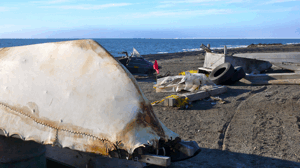
Different modes of transport — a seal skin boat, a snow machine and a sled - sit on the beach in Barrow, Alaska. White sea ice is visible in the distance. (Photo: Molly Loomis)
The Oil Spill Commission said despite pervasive problems in the oil and gas industry, efforts to move forward on offshore drilling in Arctic waters should not be prevented. But many native Alaskans fear that an oil spill the magnitude of the BP Gulf blowout, will not only damage the region’s fragile environment, but also their traditional way of life. Molly Loomis visited an Inupiat village and has our report.
Transcript
GELLERMAN: It’s Living on Earth, I’m Bruce Gellerman. Much of the Gulf of Mexico remains off limits to new offshore drilling, but oil companies have big plans for Arctic waters. Royal Dutch Shell hopes to become the first company to produce oil there. But, plans for a test well off the coast of Alaska’s Arctic National Wildlife Refuge have stalled after environmentalists mounted a successful legal challenge.
Oil companies say they can safely drill in the fragile arctic environment but many native Alaskans fear that an offshore spill could ruin their livelihood and damage their culture. Molly Loomis visited an Inupiat community and has our report.
OKPEAHA: These are fossilized ivory...they’re very old pieces...
LOOMIS: Richard Okpeaha sits behind a card table at the Inupiat Heritage Center in Barrow, Alaska. Bone, ivory and whalebone pieces spread before him and he proudly shows his work to a visitor. Okpeaha and his wife carve the materials into earrings and pendants for the trickle of tourists that make their way here to the northernmost city in North America.

Different modes of transport — a seal skin boat, a snow machine and a sled - sit on the beach in Barrow, Alaska. White sea ice is visible in the distance. (Photo: Molly Loomis)
OKPEAHA: The black ones are baleen whale…
TOURIST: They’re really polished…
OKPEAHA: And the white there is ivory…
LOOMIS: Okpeaha finds his carving treasures in the Beaufort Sea. Known for its extreme weather and temperatures, the Beaufort is also where Okpeaha spent countless days in his youth hunting and fishing to help feed his family and village.
OKPEAHA: We call the ocean our garden because we subsist from the ocean. If we want something from out there or something we want to eat, we go out there and look for it and find it and then bring it home. You know, it’s just like opening a refrigerator and getting something out of it and have it.
LOOMIS: But like many of his fellow Inupiat, Okpeaha worries how Barrow, which is so dependent on the health of this liquid garden, could be affected by an oil spill. Shell plans to drill in the Arctic’s Beaufort Sea have been delayed by lawsuits and government regulatory hurdles.
The company wants to build shallow wells, which it says minimizes the risks of an oil disaster like the kind that spewed hundreds of millions of gallons of oil into the Gulf of Mexico last year. Shell says the proposed wells in the Beaufort Sea would be in water just 150 feet deep compared to the deepwater wells in depths of 5-10,000 feet. The shallow wells are subject to less pressure and Shell calls the drilling process safe…but Richard Okpeaha doesn’t buy it.
OKPEAHA: It could be very hard for them if there’s a spill or accident or something. There’s ice out there. And, the ocean out there changes real quick in the current, and I completely oppose them drilling out there in the ocean.
LOOMIS: The ocean means more than just food for native Alaskans. It’s the focus of the village’s community organization, its relationships and activities.
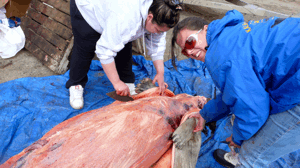
Katherine Martin (left) and Lillian Kaleak harvest the meat, blubber and skin from a bearded seal. (Photo: Molly Loomis)
[WOMEN’S VOICES. SOUNDS OF THREE WHEELERS DRIVING BY.]
[SCRAPING SOUNDS]
LOOMIS: On a grey Saturday morning, Diana Martin bustles around her front yard where a bearded seal lies belly up on a blue tarp. Martin coaches her daughter Katherine and friend Lillian on how to harvest the meat without damaging the carcass.
MARTIN: Even up to here you guys can keep the flippers….
LOOMIS: The meat will be frozen, dried and shared with elders. Nothing goes to waste, even the fat and oil will be used for cooking and the skin will be used to make a hunting boat.
[SHARPENING SOUNDS]
LOOMIS: Jesslie Kaleak Jr., the hunter that caught the seal, sharpens an ulu—a traditional knife shaped like a scallop. Kaleak explains how they will use the animal.
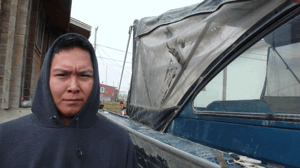
Jesslie Kaleak Jr. has followed in the footsteps of his father as a whaling captain. Barrow, Alaska. (Photo: Molly Loomis)
KALEAK: What we do is we go out on the ocean and we hunt for these so we can have our skin boats for spring whaling and so we can have the meat for the winter too. But, we use these traditional skin boats because they’re much quieter when we’re trying to hunt the bowhead whale.
LOOMIS: Kaleak is a second-generation whaling captain. He fears that an accident on future offshore rigs like Shell’s, could affect much more than just his livelihood.
KALEAK: We’ll pretty much lose our food, our way of life that we’ve been doing for many years; our ancestors passed on for us to hunt. These bearded seals, bowhead whales, all the animals that live in the ocean. Our food our elders taught us to hunt these so we don’t starve in this cold environment up here.
LOOMIS: Kaleak isn’t being dramatic when he says, “starve.” Food is incredibly expensive with staples like milk costing more than eight dollars a quart. Many villages are only accessed by bush plane or boat and Arctic weather can cause supply delays that leave store shelves barren.
Despite the obvious drawbacks and dangers that an oil spill could pose, not every one objects to the idea of offshore drilling. While the Inupiat Community of the Arctic Slope, which represents eight native villages, is against it, the native village of Wainwright and the Arctic Slope Regional Corporation, which is in charge of the area’s business interests, back it. It’s a contentious subject that divides communities and even families like the Kaleaks. Jesslie’s wife Lillian laughs nervously before admitting she’s a supporter.
LILIAN KALEAK: I’m not against it because I feel like homeland oil would benefit the whole country and I think that as long as they’re educated about all aspects of oil drilling, why not.
LOOMIS: Advocates focus on the benefits of energy independence and the jobs that drilling would bring local communities. Shell currently employs over one hundred Inupiat in jobs related to offshore energy development. And a study by the University of Alaska Anchorage estimates that new development could create up to 35,000 jobs statewide over the course of four to five decades.
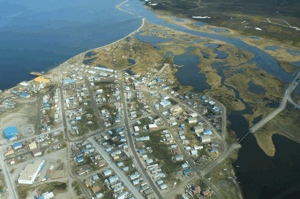
A view from the air of Kotzebue where Alex Whiting works as the village’s Environmental Specialist. (Photo: Molly Loomis)
But while job creation is one of the main reasons some native Alaskans support offshore drilling, Alex Whiting, an environmental specialist for the Village of Kotzebue, believes their logic is misguided.
WHITING: For a lot of people I guess at the end of the day they probably won’t see any economic benefit out of it, or very little. Yet everyday they’ll take a risk with the food out there that available and accessible to us all out there. Some people derive benefit while the entire population takes the risk and of course that’s what played out in the Gulf of Mexico.
LOOMIS: Whiting says even though there is a small risk of catastrophic event, he believes the risks far outweigh the benefits.
[SOUNDS OF CROWD NOISE, MEN CHEERING, WIND NOISE OF BLANKET TOSS]
LOOMIS: At an Inupiat whaling festival in Barrow, a circle of men flap a large seal skin blanket up and down, tossing boys dressed in traditional hooded jackets and blue jeans, high into the air.
[CROWD: ONE, TWO, THREE HEAVE! (LAUGHTER, CHEERING.)]
LOOMIS: Jaime Lowery stands on the sidelines, bundled against the cold night air in a long coat with a white ruff of wolf fur, and celebrates with her neighbors.
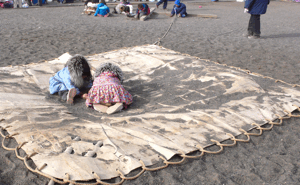
Two children play on a seal-skin blanket waiting for the blanket toss to begin. Barrow, Alaska. (Photo: Molly Loomis)
LOWERY: This festival is Inuputak - it’s a blanket toss. It’s here for our community and the different whaling crews to celebrate together. It’s just family, it’s love, it’s tradition, it’s great.
LOOMIS: Lowery is among Inupiats who have benefited from offshore drilling in the Arctic. Last year she began working as a marine mammal observer for the Arctic Slope Regional Corporation, monitoring the health of animal populations like bowhead whales. But Lowery calls the job bittersweet. She enjoys doing work to protect animals but it wasn’t until the end of the training that she learned how the information she and her co-workers collect will be used to help Shell proceed with drilling.
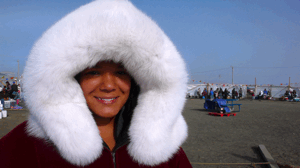
Jaime Lowery describes her job as a marine mammal observer as “bittersweet.” Barrow, Alaska. She wears a traditional coat made from locally harvested fur. (Photo: Molly Loomis)
LOWERY: It’s pretty controversial and contradicting to what we believe in here in the Arctic. This is our life style. This is our subsistence. It isn’t recreational.
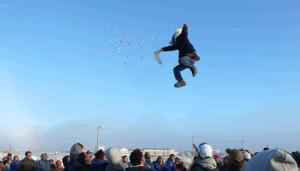
A boy tosses candy to the crowd after being thrown high into the air at a whaling festival blanket toss. Barrow, Alaska. (Photo: Molly Loomis)
LOOMIS: Shell has already spent over 80 million dollars on offshore oil leases in the Beaufort Sea and is determined to continue moving forward to get permission to drill. Many Inupiat and other Alaskans are resigned to the notion that it’s not a question of if offshore drilling will occur, but when. They hope that the lessons learned in the Gulf of Mexico will not be forgotten as the Federal Bureau of Ocean and Energy Management reviews Shell’s application. For Living on Earth, I’m Molly Loomis in Barrow, Alaska.
Living on Earth wants to hear from you!
Living on Earth
62 Calef Highway, Suite 212
Lee, NH 03861
Telephone: 617-287-4121
E-mail: comments@loe.org
Newsletter [Click here]
Donate to Living on Earth!
Living on Earth is an independent media program and relies entirely on contributions from listeners and institutions supporting public service. Please donate now to preserve an independent environmental voice.
NewsletterLiving on Earth offers a weekly delivery of the show's rundown to your mailbox. Sign up for our newsletter today!
 Sailors For The Sea: Be the change you want to sea.
Sailors For The Sea: Be the change you want to sea.
 The Grantham Foundation for the Protection of the Environment: Committed to protecting and improving the health of the global environment.
The Grantham Foundation for the Protection of the Environment: Committed to protecting and improving the health of the global environment.
 Contribute to Living on Earth and receive, as our gift to you, an archival print of one of Mark Seth Lender's extraordinary wildlife photographs. Follow the link to see Mark's current collection of photographs.
Contribute to Living on Earth and receive, as our gift to you, an archival print of one of Mark Seth Lender's extraordinary wildlife photographs. Follow the link to see Mark's current collection of photographs.
 Buy a signed copy of Mark Seth Lender's book Smeagull the Seagull & support Living on Earth
Buy a signed copy of Mark Seth Lender's book Smeagull the Seagull & support Living on Earth

